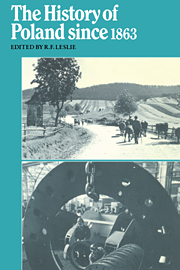Book contents
- Frontmatter
- Contents
- List of maps
- Preface to the paperback edition
- Abbreviations
- Map 1 Poland in the nineteenth century
- 1 Triloyalism and the national revival
- 2 Poland and the crisis of 1900–7
- 3 Poland on the eve of the First World War
- 4 The emergence of an independent Polish state
- 5 The breakdown of parliamentary government
- 6 Piłsudski in power, 1926–35
- 7 Poland without Piłsudski
- 8 Poland in defeat, September 1939–July 1941
- 9 The ill-fated alliance, August 1941–April 1943
- 10 The years of Tempest, May 1943–December 1944
- 11 Post-war Poland
- 12 The rise and ebb of stalinism
- 13 The October turning point
- 14 ‘The little stabilization’
- 15 The decline of Gomułka
- 16 Poland under Gierek
- 17 Polish society, 1945–75
- Epilogue: The rise and fall of Solidarity
- Notes
- Select bibliography
- Index
7 - Poland without Piłsudski
Published online by Cambridge University Press: 26 December 2009
- Frontmatter
- Contents
- List of maps
- Preface to the paperback edition
- Abbreviations
- Map 1 Poland in the nineteenth century
- 1 Triloyalism and the national revival
- 2 Poland and the crisis of 1900–7
- 3 Poland on the eve of the First World War
- 4 The emergence of an independent Polish state
- 5 The breakdown of parliamentary government
- 6 Piłsudski in power, 1926–35
- 7 Poland without Piłsudski
- 8 Poland in defeat, September 1939–July 1941
- 9 The ill-fated alliance, August 1941–April 1943
- 10 The years of Tempest, May 1943–December 1944
- 11 Post-war Poland
- 12 The rise and ebb of stalinism
- 13 The October turning point
- 14 ‘The little stabilization’
- 15 The decline of Gomułka
- 16 Poland under Gierek
- 17 Polish society, 1945–75
- Epilogue: The rise and fall of Solidarity
- Notes
- Select bibliography
- Index
Summary
Political changes after 1935
The death of Piłsudski created a major crisis for the régime he had created. Although ill and unable to take any real part in government in the last years of his life, Piłsudski personified an ultimate authority which could settle all disputes over the direction of policy and which could preserve the unity of the heterogeneous groups which supported him. His death thus forced into the open the deep divisions within the Sanacja because there was no one among his followers who could assume his mantle. This was immediately evident in the crisis over the succession. On a number of occasions Piłsudski had informed his entourage that the office of president, with the vast powers it enjoyed under the new constitution, was to be held by Walery Sławek, who had again become prime minister at the end of March 1935. Sławek, the marshal's closest confidant, was not a happy choice. A man of irreproachable honour and decency, he was politically naive and quite unfitted for the heavy responsibilities of power. He was accustomed to implementing Piłsudski's instructions without question and was shattered by his idol's death. Alexander Prystor, who was deputed by the inner group of colonels to rouse him from his inactivity in the tense period after Piłsudski's funeral, remarked that he believed even then that ‘ Walery at a moment's notice would reach for the telephone to ask the commander for an appointment’.
Sławek's obvious incapacity caused President Mościcki to resist the pressure of Piłsudski's inner circle to resign his office.
- Type
- Chapter
- Information
- The History of Poland Since 1863 , pp. 186 - 208Publisher: Cambridge University PressPrint publication year: 1980



